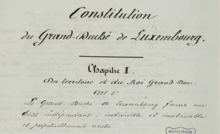Parts of this article (those related to the 23 October 2008 amendment(s), published December 2008) need to be updated. (November 2010) |
| Law of October 17, 1868 revising the Constitution of November 27, 1856 | |
|---|---|
 | |
| Overview | |
| Original title | Loi du 17 octobre 1868 portant révision de la Constitution du 27 novembre 1856 |
| Jurisdiction | Luxembourg |
| Ratified | 17 October 1868 |
| System | Parliamentary Monarchy |
| Government structure | |
| Branches | Three (executive, legislature and judiciary) |
| Head of state | Grand Duke |
| Chambers | Chamber of Deputies of Luxembourg |
| Executive | Grand Duke and their Government Prime minister as head of government |
| Judiciary | Constitutional Court |
| Federalism | No |
| Electoral college | No |
| First legislature | 17 December 1868 |
| First executive | Servais Ministry |
| Last amended | 2020 |
| Citation | Mémorial A n° 23 de 1868 |
| Location | Archives nationales de Luxembourg |
| Signatories | Gustave d'Olimart, Emmanuel Servais, Édouard Thilges, Henri Vannérus, Alexandre de Colnet-d'Huart, and William III of the Netherlands |
| Supersedes | 1856 Constitution of Luxembourg |
 |
|---|
The Constitution of Luxembourg (Luxembourgish: Lëtzebuerger Constitutioun/Verfassung; French: Constitution du Grand-Duché de Luxembourg; German: Luxemburgische Verfassung) is the supreme law of the Grand Duchy of Luxembourg. The modern constitution was adopted on 17 October 1868.[1]
Whilst the constitution of 1868 marked a radical change in Luxembourg's constitutional settlement, it was technically an amendment of the original constitution. That original constitution was promulgated on 12 October 1841,[2] came into effect on 1 January 1842,[3] and was acutely amended on 20 March 1848,[4] and again on 27 November 1856.[5]
Luxembourg first emerged as a legitimate principality in the 14th century.[6] It lived under successive Burgundian, Spanish, French, Austrian sovereignty, until 1815 when the Congress of Vienna erected it into a grand duchy and assigned it to William I, King of the Netherlands.[7] However, it was not annexed to the Kingdom of the Netherlands; instead, it formed a personal union within the German Confederation created by the Congress of Vienna.[7]
When the 1866 Austro-Prussian War led to the dissolution of the German Confederation, the Treaty of London (11 May 1867), which was drawn up in the resolution of the Austro-Prussian War, established the independence of the German-speaking part of Luxembourg.[7][8]
Through the political instability from 1815 to 1868, Luxembourg was governed by five different constitutional documents.[9] The recognition of Luxembourg as an independent state in 1868 called for yet another revision of the fifth Constitution of 1856. William III agreed to grant a more liberal constitution which went on to constitute the modern 1868 Constitution which is in use today.[9] The new Constitution confirmed the principle of constitutional monarchy and the international status of Luxembourg, declaring it to be an "independent, indivisible, inalienable and eternally neutral" state.[9] Although it was first adopted on 17 October 1868, the Constitution has since been amended many times in order to adapt with the evolving times.
- ^ (in French and German) "Mémorial A, 1868, No. 25" (PDF). Service central de législation. Archived from the original (PDF) on 27 September 2006. Retrieved 28 December 2006.
- ^ (in French and German) "Mémorial A, 1841, No. 51" (PDF). Service central de législation. Archived from the original (PDF) on 29 February 2012. Retrieved 28 December 2006.
- ^ (in French and German) "Mémorial A, 1841, No. 51" (PDF). Service central de législation. Archived from the original (PDF) on 29 February 2012. Retrieved 28 December 2006.
- ^ (in French and German) "Mémorial A, 1848, No. 23" (PDF). Service central de législation. Archived from the original (PDF) on 29 February 2012. Retrieved 28 December 2006.
- ^ (in French and German) "Mémorial A, 1856, No. 28" (PDF). Service central de législation. Archived from the original (PDF) on 29 February 2012. Retrieved 28 December 2006.
- ^ Doe, John (9 October 2017). "Historical development". Eurydice – European Commission. Retrieved 4 January 2022.
- ^ a b c "The Binding Effect Upon the German Empire of the Treaty of London of 1867 Neutralizing Luxemburg". American Journal of International Law. 9 (4): 948–958. October 1915. doi:10.2307/2187007. ISSN 0002-9300. JSTOR 2187007. S2CID 246007480.
- ^ In 1830, Belgium revolted against its union with the Netherlands causing Luxembourg to be divided between Belgium and Holland.
- ^ a b c Jean., Thill (2004). Constitutional Law of 15 EU Member States : the Grand Duchy of Luxembourg. Kluwer. OCLC 773788534.